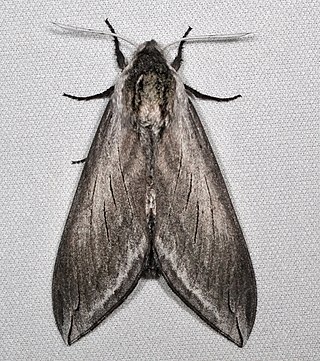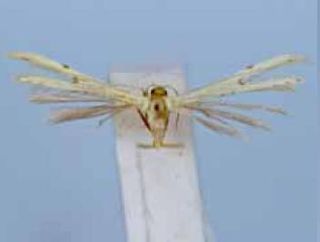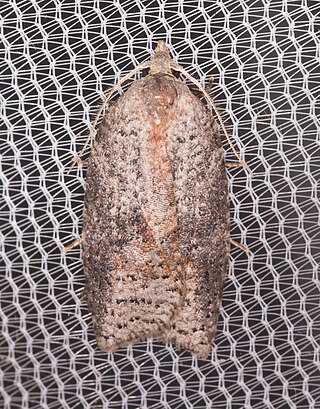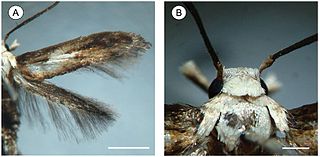
The Tephritidae are one of two fly families referred to as fruit flies, the other family being the Drosophilidae. The family Tephritidae does not include the biological model organisms of the genus Drosophila, which is often called the "common fruit fly". Nearly 5,000 described species of tephritid fruit fly are categorized in almost 500 genera of the Tephritidae. Description, recategorization, and genetic analyses are constantly changing the taxonomy of this family. To distinguish them from the Drosophilidae, the Tephritidae are sometimes called peacock flies, in reference to their elaborate and colorful markings. The name comes from the Greek τεφρος, tephros, meaning "ash grey". They are found in all the biogeographic realms.

Sphinx perelegans, commonly known as the elegant sphinx, is a species of hawkmoth described by Henry Edwards in 1874. It is a large gray moth native to western North America.

Adaina simplicius is a moth of the family Pterophoridae. It is found in the United States, Brazil, Costa Rica, Ecuador, Paraguay and Puerto Rico. It was introduced to South Africa for study as a biological control agent for Eupatorium macrocephalum.

Monoptilota is a genus of snout moths. It was described by George Duryea Hulst in 1900. It contains only one species, the lima-bean vine borer moth, which is found in the central and south-eastern parts of the United States.

Combretum erythrophyllum, commonly known as the river bushwillow, is a medium to large-sized, spreading tree found in bush along river banks in southern Africa. It is planted as a shade and ornamental tree in South Africa and the United States, and is propagated by seed.
Palaeomystella tibouchinae is a moth of the family Agonoxenidae. It is found in Brazil.
Palaeomystella henriettiphila is a moth of the family Agonoxenidae. It is found in Brazil.
Caryocolum siculum is a moth of the family Gelechiidae. It is found on central and south-eastern Sicily.

Amorbia humerosana, the white-lined leafroller, is a species of moth of the family Tortricidae. It is found from the Gulf states to the northeastern United States and southeastern Canada.
Sparganothoides machimiana is a species of moth of the family Tortricidae described by William Barnes and August Busck in 1920. It is found from the mountains and woodlands of Arizona, Colorado and New Mexico in the United States south to Durango in Mexico. The habitat consists of mixed forests and oak woodlands.
Saphenista bimaculata is a species of moth of the family Tortricidae. It is found in Costa Rica.
Saphenista muerta is a species of moth of the family Tortricidae. It is found in Costa Rica.

Eucosma metzneriana, the mugwort bell, is a species of moth of the family Tortricidae. It is found on Sicily and in Great Britain, the Netherlands, Belgium, Luxembourg, France, Germany, Denmark, Austria, Switzerland, Italy, the Czech Republic, Slovakia, Slovenia, Hungary, Bulgaria, Romania, Poland, Sweden, Finland, the Baltic region, Ukraine, Russia, North Africa, Transcaucasia, Asia Minor, Iran, Kazakhstan, Kyrgyzstan, Mongolia, China, Korea and Japan.

Eucosma aspidiscana, the golden-rod bell, is a species of moth of the family Tortricidae. It is found in China, Mongolia, Korea, Japan, Russia, North Africa and most of Europe. The habitat consists of woodlands, downland, waste grounds and cliffs.

Palaeomystella fernandesi is a moth of the family Agonoxenidae. It is found in Atlantic rain forest of Brazil.
Palaeomystella rosaemariae is a moth of the family Agonoxenidae. It is found in the Atlantic Forest of Coxilha das Lombas in Brazil.
Palaeomystella tavaresi is a moth of the family Agonoxenidae. It is found in the Atlantic Forest at the Serra Bonita Reserve in Brazil.
Dicepolia roseobrunnea is a moth in the family Crambidae. It was described by Warren in 1889. It is found from central and northern Bolivia and south-eastern Peru to north-eastern Brazil, from the Pantanal to the coastal range of the northern Andes, Trinidad, Guyana, Suriname and French Guiana. It has also been recorded from Honduras.
Filatima loowita is a moth of the family Gelechiidae. It is found in the United States, where it has been recorded from Washington.
Apatetris tamaricicola is a moth of the family Gelechiidae. It was described by Lord Walsingham in 1911. It is found in Algeria.








